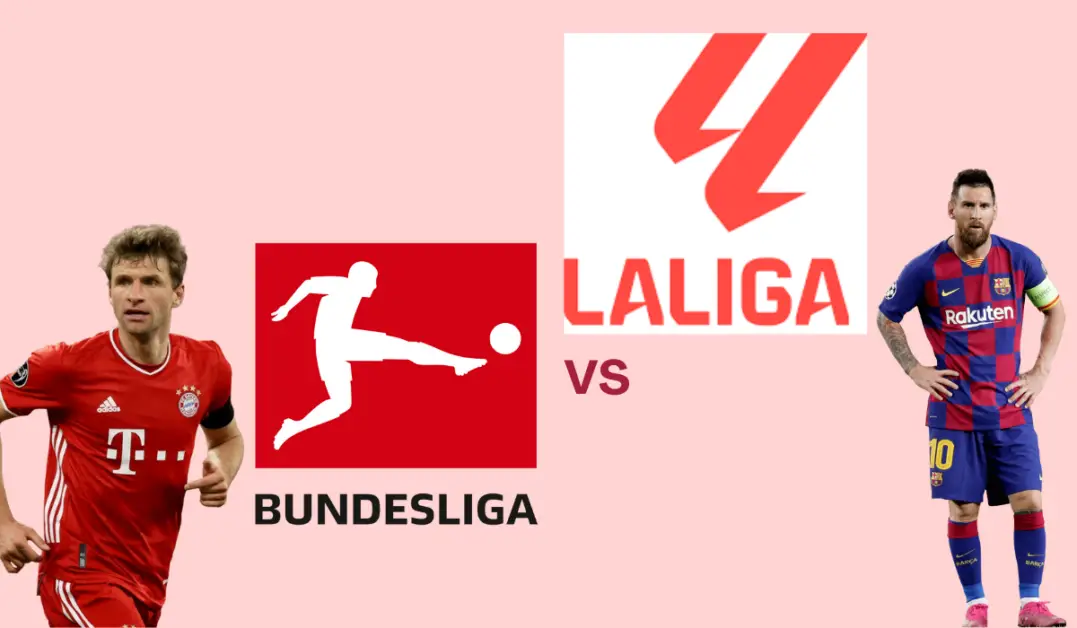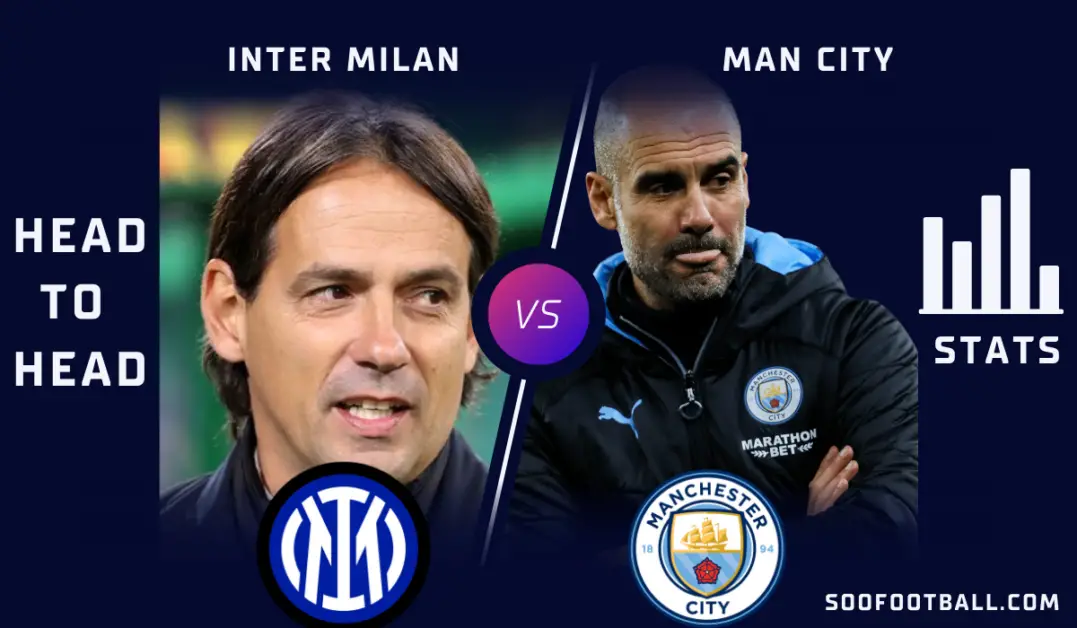Among the numerous football leagues around the globe, the Bundesliga and La Liga have consistently stood out as two of the most competitive and exciting. As avid fans of the beautiful game, we’re no strangers to the impassioned arguments and comparisons made between these two European powerhouses. Bundesliga vs La Liga head to head – it’s a showdown that never seems to lose its allure.
This article explores their historical significance, the key differences in playing style, their top clubs, legendary players, and much more.
So, if you’ve ever found yourself embroiled in a friendly (or not-so-friendly) debate about which league deserves the top spot, this is the ultimate guide to settling the score.
It is important to mention that the statistical data used for this comparison is derived from official match statistics from Opta and Whoscored – an average for the past five seasons.
Playing Style
Here, we’ll compare the head to head playing style of Bundesliga vs La Liga and justify them with credible stats.
Read Also: Premier League vs La Liga
High-Intensity Pressing vs. Possession-Based Play
Bundesliga teams are more inclined to engage in high pressing, completing an average of around 20.6 tackles per game in the last 5 seasons. In contrast, La Liga recorded an average of 16.8 tackles per game.
This suggests that Bundesliga teams are more aggressive in winning back possession. However, La Liga thrives on maintaining control, boasting a higher average possession percentage, typically around 55-60%, compared to the Bundesliga’s 45-50%.
Read Also: What Are The Treble-winning Teams In Football?
Direct Play vs. Precise Passing
The Bundesliga’s direct style of play is evident in the higher number of long passes, with an average of approximately 1,500 long passes per game, while La Liga typically registers around 1,000 long passes per game.
In contrast, La Liga places a strong emphasis on precise passing, evident in its higher pass completion rate of 85-90%, compared to the Bundesliga’s 75-80%.
Aerial Duels vs. Successful Dribbles
The Bundesliga emphasizes aerial duels, with an average of 50-55 aerial duels per game during the last 5 seasons. La Liga typically saw 35-40 aerial duels per game. La Liga players excel in dribbling, averaging around 30-35 successful dribbles per game, compared to Bundesliga players who complete 20-25 successful dribbles per game.
Build-Up Play
La Liga showcases intricate build-up play, as demonstrated by the average number of passes per sequence. In the 2020-2021 season, La Liga recorded sequences with an average of 5-6 passes before a shot, whereas the Bundesliga typically had sequences with 3-4 passes before a shot.
Read Also: Premier League vs Bundesliga
Top Club Impact
Bayern Munich is undeniably the dominant force in the Bundesliga. The club’s impact is reflected in its staggering 30 Bundesliga titles, making it the most successful club in the league’s history. Furthermore, Bayern Munich has consistently performed well in UEFA competitions, winning the UEFA Champions League multiple times.
On the other hand, Real Madrid is a giant not only in La Liga but also on the global stage. The club has clinched 35 La Liga titles, highlighting its domestic dominance. In addition, Real Madrid has enjoyed immense success in the UEFA Champions League, winning the competition 14 times. Hence, solidifying its impact on European football.
When comparing the impact of top clubs in the Bundesliga and La Liga, it’s evident that Bayern Munich and Real Madrid share similarities. Both are consistent domestic champions and possess a strong presence in European competitions. However, the key difference lies in the competitive dynamics of their respective leagues.
Read Also: Real Madrid vs Barcelona All Time Team Stats
Fan Experience and Global Reach
The Bundesliga is celebrated for its vibrant in-stadium atmosphere. During the 2019-2020 season, the league recorded an average attendance of approximately 42,700 spectators per match, which is one of the highest among football leagues globally. The passionate and engaged fan culture in Germany adds a unique dimension to the Bundesliga experience.
La Liga boasts iconic stadiums, with the Camp Nou, home to Barcelona, and Santiago Bernabeu, the residence of Real Madrid, being two of the most renowned. These stadiums have a combined seating capacity of around 175,000 spectators.
During the 2019-2020 season, La Liga matches at these venues often saw average attendance figures of over 70,000 fans. The passionate and vibrant atmosphere created by these supporters adds to the legendary status of La Liga matches, making them a remarkable experience for fans worldwide.
In addition, the Bundesliga enjoys a strong international following, with its matches broadcast in more than 200 countries, making it one of the most widely televised leagues. The presence of globally recognized clubs like Bayern Munich enhances the league’s global reach.
La Liga is no stranger to international success either. During the 2021-2022 season, for example, La Liga was broadcast in over 180 countries, accumulating an estimated 2.7 billion cumulative viewers.
The league’s global appeal is significantly influenced by football giants like Barcelona and Real Madrid, as well as renowned football stars, such as Jude Bellingham.
Financial Aspects and Player Transfers
The Bundesliga excels in youth development and profitable player sales, exemplified by Erling Haaland’s €60 million transfer to Man City in 2022.
La Liga, particularly with clubs like Barcelona and Real Madrid, has been involved in high-profile and record-breaking player transfers, such as Neymar’s €95 million move to Barcelona and Cristiano Ronaldo’s €94 million transfer to Real Madrid.
Conclusion
After our comprehensive head to head analysis of the Bundesliga vs La Liga, it’s challenging to definitively declare one league as superior to the other. Both leagues have their unique strengths and qualities that make them incredibly appealing to fans around the world.
The Bundesliga stands out with its financial stability and focus on sustainable practices, while La Liga exhibits strong financial prowess and has been a magnet for high-profile player transfers. These distinctions add depth and diversity to the global football landscape.
In the end, the beauty of football lies in its diversity. The Bundesliga’s grit and intense fan culture offer an experience that’s cherished by many, while La Liga’s flair and presence of football giants make its matches captivating in their own right. What truly matters is the joy and passion that both leagues bring to millions of fans worldwide.
Each league has its legends, its moments of brilliance, and its unique contributions to the global football narrative. Whether it’s the Bundesliga’s iconic ‘Yellow Wall’ at Signal Iduna Park or the mesmerizing skills displayed at the Camp Nou, both leagues remind us that football is more than just a sport; it’s a rich tapestry of stories, emotions, and unforgettable moments.
The beauty of football is that there’s room for both the Bundesliga and La Liga to shine, each in its own remarkable way.






